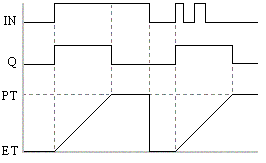TP / TPR
Inputs
|
Input |
Data type |
Description |
|
IN |
BOOL |
Timer command. |
|
PT |
TIME |
Programmed time. |
|
RST |
BOOL |
Reset (TPR only). |
Outputs
|
Output |
Data type |
Description |
|
Q |
BOOL |
Timer elapsed output signal. |
|
ET |
TIME |
Elapsed time. |
Time diagram

Remarks
The timer starts on a rising pulse of IN input. It stops when the elapsed time is equal to the programmed time. A falling pulse of IN input resets the timer to 0, only if the programmed time is elapsed. All pulses of IN while the timer is running are ignored. The output signal is set to TRUE while the timer is running.
TPR is same as TP but has an extra input for resetting the timer
In LD language, the input rung is the IN command. The output rung is Q the output signal.
ST Language
MyTimer is a declared instance of TP function block.
MyTimer (IN, PT);
Q := MyTimer.Q;
ET := MyTimer.ET;
FBD Language

LD Language

TP / TPR |
|
IEC 61131-3 Automation platform > Programming - Reference guide > Timers > TP / TPR |
Created with the Personal Edition of HelpNDoc: How to Protect Your PDFs with Encryption and Passwords

